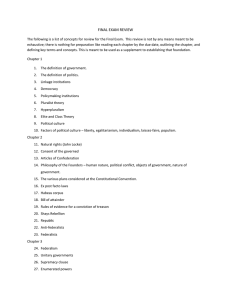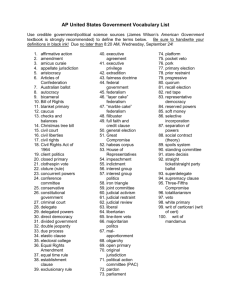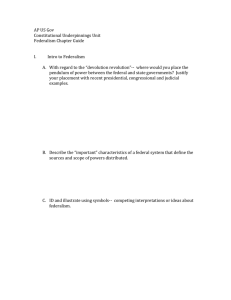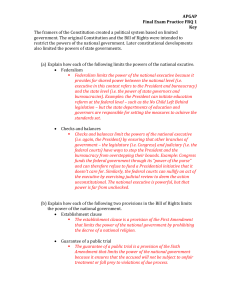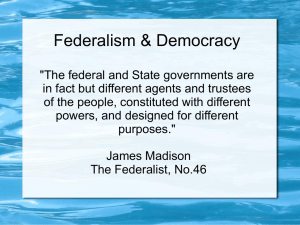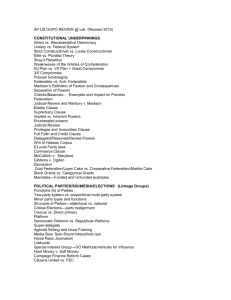Constitutional Framework
advertisement
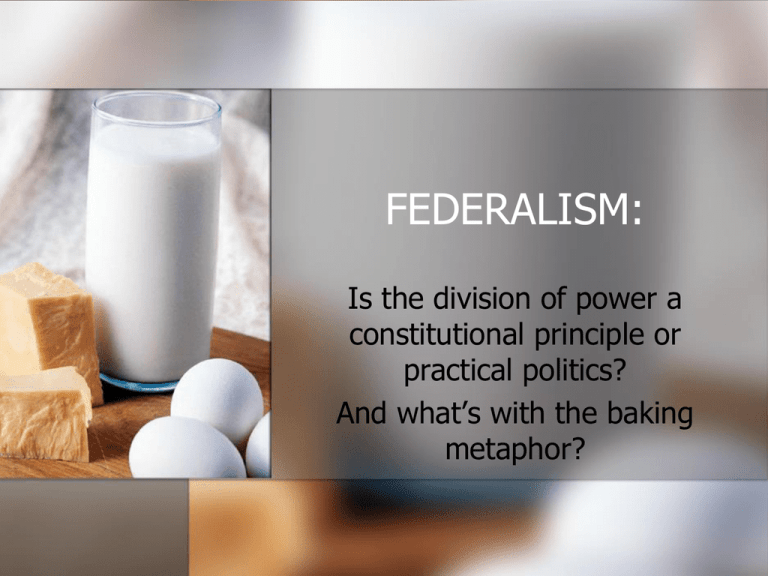
FEDERALISM: Is the division of power a constitutional principle or practical politics? And what’s with the baking metaphor? Interests and Powers What are the interests of state governments? What are the interests of the federal government? What powers should states have? What powers should the federal government have? Bakery Metaphors (yummm) Dual Federalism Until 1930s Like a layer cake Dual Federalism in parts: Nat’l Gov has enumerated powers only Each government has own sphere of sovereignty More tension than cooperation Cooperative Federalism After 1930s Like a marble cake Rejects the idea of “spheres” Government action is jointly taken Nation and states routinely share power Power is fragmented enough that it cannot be concentrated at any level So what’s the critical difference? It’s all in how we interpret two sections of the Constitution . . . Article I, Section 8 enumerates powers (and there is that pesky elastic clause) Tenth Amendment reserves for the states and the people powers not assigned to the national government Cooperative Dual Elastic clause is inflexible and Tenth Amendment is capacious (capable of containing a great deal) Elastic Clause is just that, elastic. It aslo confines the Tenth Amendment to a self-evident truth So what do Article I and the Tenth Amendment actually tell us? Of the following list, which are mainly state powers? Federal? Both? Collect Taxes Define Private Property Regulate Marriages Regulate Commerce Administer Health and Safety Rules Coin Money Regulate Labor Raise an Army Enforce Criminal Codes Regulate Professional Standards Declare War Administer Drivers’ Licenses Expressed Powers Article I, Section 8 of the Constitution Regulate Interstate Commerce (the commerce clause) Coin Money Borrow Money Raise an Army Declare War Are there more? Absolutely! Implied Powers Article I, Section 8, clause 18 The Elastic Clause Congress’ power to make all laws “necessary and proper” to carry out expressed powers The Tenth Amendment The powers not delegated to the United States by the Constitution, nor prohibited by it to the States, are reserved to the States respectively, or to the people. Reserved Powers Derived from the Tenth Amendment Define Private Property Regulate Marriage Administer Health and Safety Rules Enforce Criminal Codes Regulate Professional Standards Administer Drivers’ Licenses Are there more? Absolutely! Concurrent Powers Are Shared Collecting taxes Regulate Labor Regulate Commerce Federalism in Practice What are the forces that change the face of federalism? (What has contributed to the increase in Federal Power) National Crises and Demands Judicial Interpretations Grants-in-Aid Professionalization of state governments National Crises and Demands Civil War Both World Wars Great Depression 9/11 All of these involved problems that were too extensive for states to handle alone National relief funds spent on states are often attached to federal stipulations Katrina and Federalism Judicial Interpretation McCulloch v. Maryland 1819 Expanded the role of national government Does Congress have the power to establish a national bank? If so, could a state tax the bank? Yes, and No. “The power to tax is the power to destroy” Cooperative federalism (direct relationship between the people and national government) Shifts in Judicial Interpretation ever since Judicial Interpretation Gibbons v. Ogden, Marbury v. Madison, and Korematsu v. US all increased the power of the federal government Grants-in-Aid Financial incentives influence state behavior (because the money comes with “strings”) Two forms: Categorical Block Categorical Grants For a specific purpose Little discretion by recipient government Formula: very specific rules such as Per capita income Number of school age children Project: competitive applications Health (HIV-AIDS programs) Natural Resources (Radon, asbestos, energy) Block Grants Recipient governments have more discretion over funds Welfare Reform Act of 1996 States were given power and money to run their own welfare program States were given discretion to determine how to implement the goal of getting people to work Professionalization of State Governments States have become more forceful policy actors Education (NCLB) http://www.ed.gov/nclb/overview/intro/execsumm.html Health Care (S-CHIP) http://www.chicagotribune.com/news/nationworld/chi-kidshealth-care_thufeb05,0,30310.story Same sex marriage laws Federal Government makes laws that foster such programs States have obligations to one another Full Faith and Credit Clause Article IV, Section I “Full Faith and Credit shall be given in each State to the public Acts, Records, and judicial Proceedings of every other State. And the Congress may by general Laws prescribe the Manner in which such Acts, Records and Proceedings shall be proved, and the Effect thereof.” Marriage, Divorce, Custody and Adoption Defense of Marriage Act Loving v. Virginia More obligations . . . Comity Clause Article IV, Section 2: “The Citizens of each State shall be entitled to all Privileges and Immunities of Citizens in the several States.” AZ can’t pass a law prohibiting NM residents from traveling, owning property, or working in AZ And more . . . Interstate Commerce Clause Article I, Section 10 “No state shall, without the consent of the Congress . . . enter into any Agreement or Compact with another other State . . . ” Water Rights Has, more than any other clause, increased the power of the federal government Unfunded Mandates Setting National Standards – but not paying for them New Federalism and Devolution New Federalism Reagan, Nixon, and Clinton Return more discretion to the states Devolution Giving the states more power over policy Simulation http://www.wwnorton.com/lowi8/chapt ers/ch03/simulation.asp


